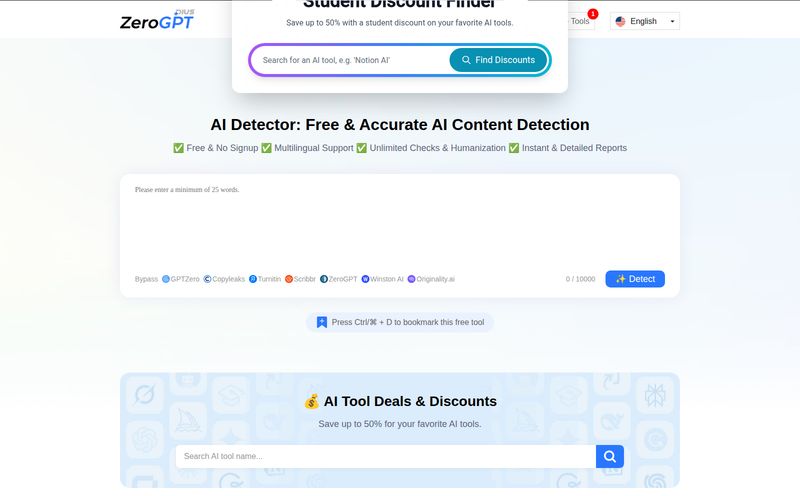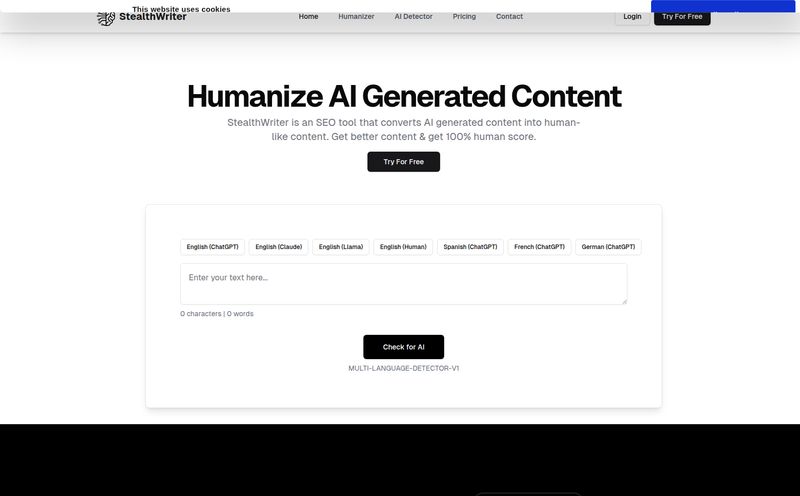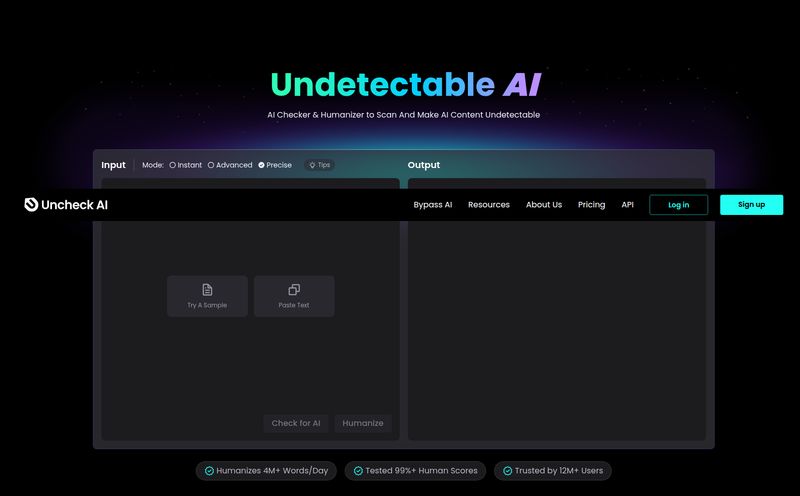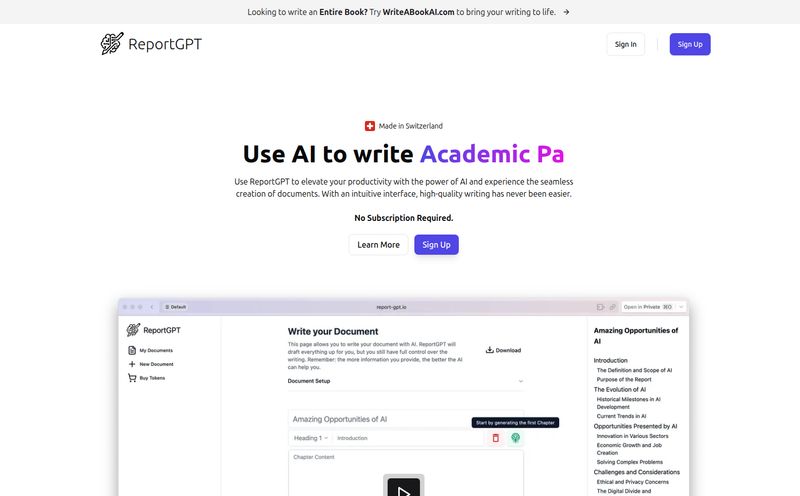The content world has gotten... weird. We're all riding this massive AI wave, and while it's a fantastic tool for brainstorming and busting through writer's block, it's also created a bit of a trust issue. Ever read something that sounds just a little too polished, a little too perfect? Yeah, me too.
As an SEO blogger, my entire career is built on originality and authority. For years, the big bad wolf was simple plagiarism—copy-paste jobs that would get you slapped by Google. We had tools for that. But now, we're fighting a two-front war: old-school plagiarism and the new, slick, hard-to-spot AI-generated text. Finding a single tool that can act as a watchdog for both without costing an arm and a leg has been a genuine challenge. So when I stumbled upon CopyFind.ai, which claims to be a free tool for both, my curiosity was definitely piqued.
So, What Exactly is CopyFind AI?
In a nutshell, CopyFind AI is a web-based tool designed to be your first line of defense against unoriginal content. It’s not just another plagiarism checker that matches text against a database. It goes deeper. It positions itself as a dual-threat detector, sniffing out not only directly copied text but also heavily paraphrased sentences and content that was likely spat out by an AI model. Think of it as a digital bloodhound for content authenticity. For bloggers, students, teachers, anyone who deals in words, this is a pretty compelling pitch.
Diving into the Core Features
Okay, so it talks a big game. But what's under the hood? I spent some time kicking the tires, and a few things really stood out.
More Than Just a Copy-Paste Cop
The first thing to mention is its approach to plagarism. Standard checkers are good at finding exact matches. But what about the clever paraphrasing? The kind where someone (or something) just swaps out a few words with synonyms to fly under the radar. CopyFind AI claims to be smart enough to detect this. This is huge. It means it's looking for structural and semantic similarities, not just a string of identical words. In my experience, this is where many free tools fall flat, but it's a critical feature for maintaining true originality.
The In-Built AI Content Detective
This is the feature that really grabbed my attention. The ability to detect AI-generated content is becoming less of a novelty and more of a necessity. With Google's constant updates and emphasis on content with real Experience, Expertise, Authoritativeness, and Trustworthiness (E-E-A-T), you can't afford to have your site filled with generic, robotic text. An AI detector built right into your plagiarism workflow saves a ton of time. You're not just checking if the content is stolen; you're checking if it's even human. A crucial distinction in 2024.
It’s Surprisingly Flexible and Easy to Use
I’m a big fan of simple UIs. I don’t want to read a manual to check a piece of text. The interface here is clean and straightforward. You can copy-paste your text directly, or—and this is a nice touch—upload a file. It supports .txt, .pdf, and .docx, which covers pretty much all the bases. Another neat feature is the ability to compare your text against a specific URL. Want to make sure your new blog post isn't accidentally too similar to the top-ranking competitor? Just pop their URL in and let it run. Simple, effective.
My Hands-On Test Drive with CopyFind AI
Talk is cheap, right? So I took it for a spin. I grabbed a paragraph from an old article of mine, ran it through an AI paraphraser to mix it up, and then added a sentence I generated with ChatGPT. I pasted the whole 250-word franken-text into CopyFind AI.
The process was quick. The results came back showing the paraphrased section as having a high percentage of similarity to my original article (good catch!) and, more impressively, it flagged the AI-generated sentence with a high probability of being machine-generated. It wasn't just a yes/no answer either; it gave a percentage score, which I appreciate. It allows for a bit of nuance.
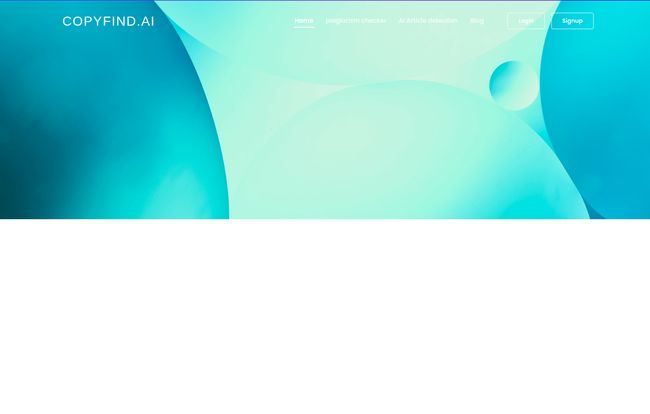
Visit CopyFind AI
The interface was intuitive. No clutter, no confusing options. Just a box for your text, a button to check it, and a clear results page. It's the kind of tool you can have bookmarked and use in 30 seconds without breaking your workflow.
The Good, The Bad, and The Confusing
No tool is perfect, and my job is to give you the full picture, not just the glossy brochure version.
What I Genuinely Liked
First off, the core functionality is solid. The fact that it's a free tool offering both plagiarism and AI detection is its biggest selling point. Most platforms make you choose or pay a premium for that combo. The accuracy in my little test was impressive, especially on the paraphrased content. The user-friendly design and file upload options are also major wins. It’s a low-friction, high-value tool for quick checks.
Some Things to Keep in Mind
Now for the catch. The free version has a word limit. From what I can see, it's around 300 words per check. That's perfect for checking a paragraph, an email, or a social media post. But for a full-length blog article? You'd have to check it in chunks, which is a bit of a pain. This naturally leads to the question of a paid plan. The site mentions a premium version is needed for more extensive use, which makes total sense. However... and this is a big however... the pricing page seems to be broken. I hit a 404 error, which suggests the tool might be very new, or they're in the middle of revamping their plans. It's a small hiccup that makes it hard to recommend for heavy users right now.
So, Who Should Be Using CopyFind AI?
Even with its limitations, I can see a few groups getting a ton of value out of this.
- Bloggers and Content Creators: It's a fantastic tool for a final spot-check on a conclusion or for verifying the originality of a guest post before it goes live.
- Students: An absolute lifesaver for checking essays and reports. The 300-word limit is less of an issue when you're just checking key paragraphs to ensure you haven't accidentally paraphrased too closely to a source.
- Teachers and Educators: A quick, free way to vet student submissions for both copy-pasting and the use of AI writing tools.
- SEO Professionals: Useful for quick content audits or analyzing a small snippet of competitor text.
Frequently Asked Questions About CopyFind AI
1. Is CopyFind AI actually free to use?
Yes, it is. There's a free tier that allows you to check text up to about 300 words at a time for both plagiarism and AI-generated content. For longer texts, you'd need to check them in sections or wait for details on their premium plan.
2. How accurate is the AI detection?
In my tests, it was surprisingly accurate. It successfully flagged content generated by a popular AI model. Like all AI detectors, it's probably not 100% infallible, but it works as a very strong indicator and is much better than having no detector at all.
3. What kind of files can I upload?
CopyFind AI supports several common file formats, making it easy to check your work without copy-pasting. You can upload .txt, .pdf, and .docx files directly to the platform.
4. Can I check my content against a specific website?
Yes, and this is a great feature for SEOs and students. There's an option to input a specific URL to compare your text against, helping you ensure your work is original when compared to a key source or competitor.
My Final Verdict on CopyFind AI
So, what's the bottom line? CopyFind AI is a promising, powerful, and—most importantly—accessible tool. The combination of plagiarism, paraphrasing, and AI detection in a free, easy-to-use package is a winning formula. The 300-word limit and the mystery of the missing pricing page are its only real drawbacks at the moment.
For quick checks, for students, and for bloggers who need a fast, reliable first pass on their content, I'd absolutely recommend giving it a shot. It has earned a spot in my bookmarks. It's a tool that understands the new reality of content creation, and I'm genuinely excited to see how it develops once they sort out their premium offering.
References and Sources
- CopyFind.ai Official Website: https://copyfind.ai/
- Google Search Central: Creating helpful, reliable, people-first content
